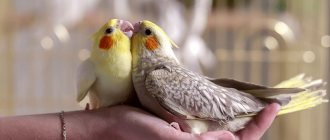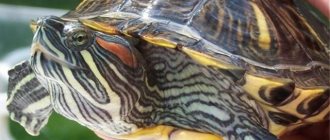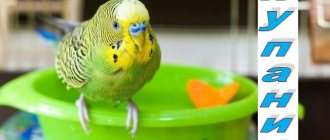Owners of budgerigars are confident that their pets will live long and carefree, delighting their owners with their trill every day. It is believed that in favorable conditions birds can live for decades. But there are always exceptions to the rules. Trouble comes unnoticed, and at one point the owner realizes that the parrot is seriously ill and will most likely die soon. What causes budgerigars, which are bred at home, to die if the birds were cared for according to all the rules? Our article provides an answer to this question.
Why do birds die at home?
In the wild, birds rarely live beyond 4 years. While at home a pet can live all 15 .
There are also centenarians who reach the 20-year mark, but this is the exception rather than the rule.
Accidents
Almost anything can happen here, from a head stuck in the bars of a cage to careless actions of the owner. Let's look at the most common causes of bird death from accidents.
Drowning
Budgerigars love water, and use its mirror surface as a play tool. But if a bird doesn't know how to swim, it can drown. Before letting your pet fly freely around the room, vases with water and aquariums should be removed from the room.
When purchasing a swimsuit, you need to take into account the size of the bird. For budgies, small containers are suitable, where the bird cannot drown even if it wants to. Whereas larger solutions, for example, for cockatoos or grays, carry danger.
Flew out onto the street
Here it is also necessary to prepare the room for flights by closing all the windows and doors . If a parrot finds itself on the street, in an unfamiliar environment, it may become confused: run into an obstacle, fall into the blades of a split system, or simply freeze from the cold.
Burn
When releasing a parrot from its cage, you should limit its flights around the kitchen, where devices and equipment dangerous to the life of the animal are concentrated. A stove, toaster, or any other heating device that is turned on can seriously injure a bird.
Other animals
If there are other pets in the house besides the bird, then it is more advisable to limit contact with them. Cats are kind and affectionate with their owners by nature as predators: it is very difficult to avoid the temptation to hunt a bird. Dogs are safe for parrots, but due to their large weight and clumsiness, they can accidentally crush the pet with their paw or body.
Small children
Children love animals and, when showing their feelings, they can inadvertently harm a fragile bird by squeezing it tightly or feeding it food that is harmful to the bird. Games with a parrot should be supervised by parents. If the child is of kindergarten age, then contacts should be limited to placing the bird on the palm.
As soon as a pet appears in the house, children should immediately be explained that it is not a toy, but a family member, and should be treated accordingly. It is necessary to teach the child to ask permission to open the cage and other contact actions.
How to treat a cell
If a parrot dies unexpectedly, it is recommended to find out the cause of death
This is especially important if there are other birds in the house. If there is a veterinary clinic and laboratory in the locality and they will do this, then this is an ideal option
Birds can suffer from contagious and dangerous diseases such as chlamydia, tuberculosis, and salmonellosis. Even if it was not possible to find out what caused the parrot’s death, the bird’s cage must be thoroughly disinfected.
You can treat the cage after the death of a parrot using the following means:
- Alkali;
- xylonaft 5%;
- creolin emulsion.
Before starting treatment, wear rubber gloves and protect your respiratory tract.
Disinfection is carried out if the pet suddenly died for unknown reasons or had parasites, bacterial and viral infections.
Diseases
The list of possible diseases in budgies is quite impressive. But if you carry out regular prevention and follow simple recommendations from specialists, then health problems can be minimized.
Has your parrot been sick?
Not really
Poor nutrition and poisoning
Many newcomers to this business make the same mistakes. The first is overfeeding. Owners think that their pet's chirping is a desire to eat. As a result, the bird develops obesity, which can be fatal in severe cases.
The pet should be fed rationed. It is better to underfeed a little than to overfeed. The main thing is that the bird always has access to water. Treating obesity is difficult and time-consuming.
Parrots should not be given certain fruits and vegetables, such as watermelons, persimmons, papaya and potatoes. Canned food and herbs are also prohibited. In addition to food, toxic substances can kill your pet. Among them are nicotine, certain herbs, rotting products and chemicals: detergents, medicinal, insecticidal and others.
Injuries
Even if a parrot lives alone in a cage, it is not immune from injury. Particularly active birds can be injured by toys, perches and rods. When a bird flies freely around the room, it is necessary to monitor its movements: stop dangerous games with interior items, and also try to close all the cracks where the parrot can get into.
Parasites as a cause of death
Infestations of ticks and worms can be fatal if left untreated. You must monitor your pet's condition every day and respond appropriately to any changes. At the first signs of invasion, it is more advisable to consult a specialist rather than self-medicate.
Frequent laying
Breeders are guilty of this factor. In pursuit of the number of young, they contribute to an increase in clutches, while the female must rest after hatching the chicks for at least 2 months. If the bird’s body does not recover, it may die during the next laying.
Other diseases
Here we have viral and bacterial infections, tumors of various types, pathologies of internal and external organs. Not all diseases can be diagnosed by external examination , and not all owners can afford to visit a veterinary clinic. As a result, pets die from chronic diseases.
Signs of imminent death
Sometimes, due to sudden death, the owner does not have time to notice any symptoms of changed behavior. But still, if the pet is sick or exposed to a critical situation, you can see agony that lasts for several hours. How can you tell if a budgerigar is dying? A fatal outcome is foreshadowed by:
- A symptom of imminent death is that the parrot lies motionless and does not react to anything. Profuse, continuous vomiting.
- Throwback, tense neck.
- Convulsions.
- The paws are straightened and tense.
- The bird lies on its belly or on its side.
- The eyes are covered with a film.
- Sudden jumping and falling of the pet.
- Onset of paralysis.
Emotional problems
Many do not take this factor into account, whereas it is psychological problems that open the door to other, more dangerous diseases. When a bird experiences constant stress, it significantly shortens its life.
Yearning
In stores, parrots are kept in groups and they never get bored. But when the pet is left alone, and the owner does not pay enough attention to it, the bird falls into apathy. As a result, the immune system is undermined, weakness appears, and the bird fades away literally before our eyes.
Buying a pet is a responsibility. He shouldn't be left alone for long. Rare visits during feeding are not enough to normalize the emotional state of the bird.
Fear and severe stress
When a parrot is constantly under severe stress, it begins to beat around the cage or, on the contrary, hides in a corner, plucking its feathers. A pet’s heart may not be able to withstand severe fright, so it should be protected from sharp sounds, for example, a washing machine, TV, or loud human screams.
Tuberculosis, Koch bacillus in parrots
Tuberculosis (eng. Mycobactérium tuberculosis ) Koch's bacillus. The causative agent of tuberculosis is by its nature a parasite, since it uses the animal’s body as an object for its existence. Its natural place of residence can only be a living organism. The external environment for him is just a temporary place of stay, where he enters from the body of a sick person or animal.
Tuberculosis is a slow-onset disease that develops over several months and leads to depletion of the body, and then to the death of the bird. The diagnosis is very difficult to make in most cases.
The causative agent of the disease enters the parrot's body, as a rule, together with food and by airborne droplets. When infected with tuberculosis, tuberculous nodules can form in the internal organs of a bird, which over time cause paralysis of the limbs.
With pulmonary tuberculosis, the parrot experiences breathing problems, and if the digestive organs are affected, severe diarrhea occurs. Tuberculosis can also affect bones and skin. Signs of the disease are: lethargy, weight loss, weakening or lack of appetite, decreased egg production, intestinal upset, damage to the joints of the legs and claws, dysfunction of internal organs, progressive anemia, the appearance of tumors and abscesses on the skin and under the skin, nodular formations on the mucous membranes .
Treatment of a parrot with tuberculosis, as a rule, does not give a positive result.
Other factors
The lifespan of a budgerigar can be influenced by a number of other factors independent of the pet itself. First of all, these are genetics and the conditions of keeping the bird.
Place of purchase
Sellers at poultry markets are not always honest with buyers and may slip old birds. In addition, only a specialist can determine the exact age of a bird after a year. The same applies to hidden diseases, so it is better to buy a pet in trusted pet stores.
Genetics
Through the process of crossing, breeders try to produce remarkable individuals. But sometimes the results of their work manifest themselves in diseases inherent at the genetic level. It is very difficult to recognize such an individual. When buying a pet, experts recommend sticking to classic shapes and colors.
Bird living conditions
If the owner cleans the cage from time to time and uses mediocre products as food, then the bird will not last long in such conditions. She faces problems with the gastrointestinal tract, infections and parasites. All this shortens the life of the parrot.
Floor
It has been noticed that male birds at home live longer than females due to the double sex chromosome. While in the wild the opposite is true. Competition for mates and territory is a consequence of the death of many males.
If your budgie is shaking
Trembling in itself is not considered dangerous to the health of the parrot, and it can be caused by disturbances in feeding or inappropriate living conditions. By correcting the shortcomings, you can easily improve the situation.
But if the trembling of the wings and tail does not go away, and the measures taken by the owner do not give the desired result, then this indicates the onset of the disease. A sick bird is shaking, its feathers are ruffled, the pet often sleeps for a long time, leaning its belly on the perch. At the same time, it does not react to extraneous sounds, does not make contact, and does not clean its feathers. Symptoms of the disease are:
- Lack of appetite. Complete refusal of food, drink and treats.
- Self-plucking. A large number of feathers with traces of blood is a very alarming sign.
- Constant scratching. Possible parasite infection.
- Difficulty breathing with the appearance of shortness of breath.
- Change in consistency and color of droppings.
- Refusal to walk around the room.
- Trauma, broken limb, open wound.
- Oral burns from feeding too hot food.
- Poisoning.
- Uncharacteristic scream.
- Loss of coordination in space.
- Purulent discharge from the cere.
If any of the symptoms are detected, you should not treat yourself. It is necessary to visit a veterinarian for diagnosis and treatment. Delay often threatens the death of your pet.
How to understand the approaching death of a bird
A number of signs indicate an imminent death. The death throes can last from one hour to several days, depending on the condition of the pet and the severity of the disease.
Signs of a bird's impending death:
disorientation;- frequent vomiting;
- throwing the head to the side;
- convulsions;
- motionless legs;
- whitish film on the eyes.
At the first sign of impending death, you should immediately contact a veterinarian. It is quite possible that the pet can be saved.
First actions
So, you have determined that your budgie is dying, what should you do? Provided that if the owner soberly assesses his capabilities and knows the symptoms of a particular situation, the first aid actions will be:
- Against vomiting and diarrhea. Soldering with liquid glucose and saline solution, 1 ml every 10 minutes.
- From a chemical burn. Solcoseryl eye gel is administered orally. They also treat the eyes and wax.
- For shock and shortness of breath. An intramuscular injection of glucocorticoid drugs is performed.
- For broken limbs. Immediate fixation is required.
- Hypothermia. You need to warm up your pet.
- In case of poisoning by toxic fumes. The cage with the parrots is moved to another room, the room is ventilated.
- In case of poisoning from a houseplant. Seal off with sorbents every hour.
If the owner is not confident in his actions, or does not know the cause of the disease, the first action will be to contact a specialist . Only in this case can the bird be saved.
What to do if the wavy dies
Good grief, but you can’t leave a dead pet at home. He needs to be buried. The fact is that birds are carriers of dangerous diseases, so it is more advisable to carry out the burial procedure no later than the next day after death.
How to bury a bird correctly
Animals cannot be buried within the city limits . You'll have to look for a place in the nearest forest belt. The parrot's body is wrapped in a piece of cloth and buried about half a meter into the ground. To prevent animals from digging up the grave, you need to lay stones or turf on top.
What to do with the cage
You cannot add other birds to the cage where your pet died without first treating it. General cleaning with complete disinfection is required. Products for the latter can be purchased both in pet stores and pharmacies, describing the nature of the problem.
Salmonellosis in parrots
Salmonellosis is an acute intestinal infection of animals and humans caused by salmonella (lat. Salmonella - a genus of non-spore-bearing bacteria). Salmonella, having entered the intestine with food and water, multiply in the small intestine, colonize the large intestine, penetrate into solitary follicles and Peyer's patches, as well as mesenteric lymphatics nodes from which they enter the blood. Inflammation develops in places of reproduction (intestinal mucosa, gall bladder, liver), which leads to subsequent necrosis.
After a short incubation period (3-4 days), the sick bird develops lethargy, depression, fever, and intestinal upset. Often, during an acute infection, blueness of the beak and paws occurs, which indicates sepsis. The stools are liquid, orange-green in color, sometimes with blood. In subacute and chronic cases, yellowness of the mucous membranes, exhaustion of the bird, and sometimes vitelline peritonitis are noted. Possible damage to the lungs, joints, brain, uterus and fetus. Death occurs from dehydration, numerous hemorrhages, intoxication and sepsis.
In the subacute course, clinical signs are not expressed and occur in the form of depression, apathy, arthritis, intestinal disorders, and conjunctivitis. Sometimes paralysis of the wings and legs occurs.
Salmonella is one of the main causative agents of severe foodborne toxic infections in humans. The incubation period is from 2-6 hours to 2-3 days, usually 12-24 hours. The onset is acute. With the gastrointestinal form, chills, headache and muscle pain, tachycardia appear, and the temperature rises to 38-39 ° C or more. At the same time, pain occurs in the epi- and mesogastrium, nausea, repeated vomiting, and frequent watery, foul-smelling stools with greens. Dehydration, convulsions, and arterial hypotension are possible.
Listeriosis in parrots
Listeriosis, the causative agent is the motile, non-spore-forming gram-positive bacillus Listeria monocytogenes , a saprozoonotic infectious disease that mainly affects newborns, pregnant women and immunosuppressed individuals. It is distinguished by clinical polymorphism with manifestations ranging from latent infection to severe damage to the nervous system and sepsis.
People's natural susceptibility is low. Diseases occur most often in the elderly, newborns, and in people with immunodeficiencies.
You will also have to decide whether to wait for your parrot to die naturally or resort to euthanasia if your parrot has one of the following diseases.
Bird flu in parrots
Bird flu is a dangerous infectious disease. Bird flu is carried by wild ducks and other birds. Bird flu is especially dangerous for parrots kept in outdoor aviaries. It occurs in birds in two forms: weak and severe. Symptoms of a weak form are: reduction in egg production, lethargy, loss of appetite, fragility and loss of feathers. And if a parrot experiences: thirst, weakness, increased body temperature, fragility, loss of feathers, damage to the respiratory system, digestive upset and damage to the nervous system, then these are already signs of a severe form of the disease.
Bird flu is extremely dangerous and spreads very quickly. The only way to prevent an epidemic is to destroy as soon as possible all infected birds, as well as those birds that were in contact with sick birds.
Campylobacteriosis in parrots
Campylobacteriosis is an acute zooanthroponotic infectious disease caused by species of bacteria of the genus Campylobacter that are pathogenic to humans. It is characterized by symptoms of intoxication with primary damage to the gastrointestinal tract. In children and weakened individuals it often occurs in the form of sepsis. The natural susceptibility of people is high, as evidenced by the high level of campylobacteriosis in children under 2 years of age. The clinical picture of the disease can vary from asymptomatic carriage to severe lesions.











